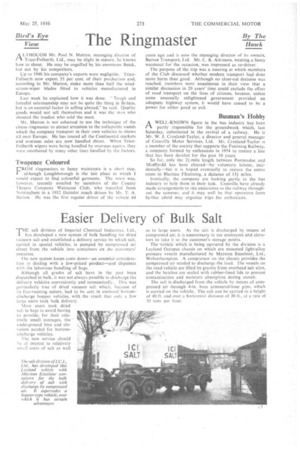Easier Delivery of Bulk Salt
Page 45

If you've noticed an error in this article please click here to report it so we can fix it.
THE salt division of Imperial Chemical Industries, Ltd., has developed a new system of bulk handling for dried vacuum salt and established a delivery service by which salt, carried in special vehicles, is pumped by compressed air direct from the vehicle into containers on the customers' premises. The new system keeps costs down—an essential consideration in dealing with a low-priced product—and dispenses with the laborious handling of bags. Although all grades of salt have in the past been dispatched in bulk, it was not always possible to discharge the delivery vehicles conveniently and economically. This was particularly true of dried vacuum salt which, because of its free-running nature, had to be sent in enclosed bottomdischarge hopper vehicles, with the result that only a few large users took bulk delivery.
Most users took dried salt in bags to avoid having to provide, for their relatively small. tonnages, the underground bins and elevators needed for bottomdischarge vehicles.
The new service should be of interest to relatively small users of salt as well as to large users. As the salt is discharged by means of compressed air, it is unnecessary to use conveyors and elevators to take it to the customer's storage points.
Thevehicle which is being operated by the division is a Leyland Octopus chassis on which are mounted light-alloy pressure vessels manufactured by Marston Excelsior, Ltd., Wolverhampton. A compressor on the chassis provides the compressed air needed to discharge the load, The vessels on the road vehicle are filled by gravity from overhead salt silos, and the hatches are sealed with rubber-lined lids to prevent contamination and moisture absorption during transit.
The salt is discharged from the vehicle by means of compressed air through 4-in, bore armoured-hose pipe, which is carried on the vehicle. The salt can be carried to a height of 40 ft. and over a horizontal distance of 30 ft., at a rate of 20 tons per hour.














































































































